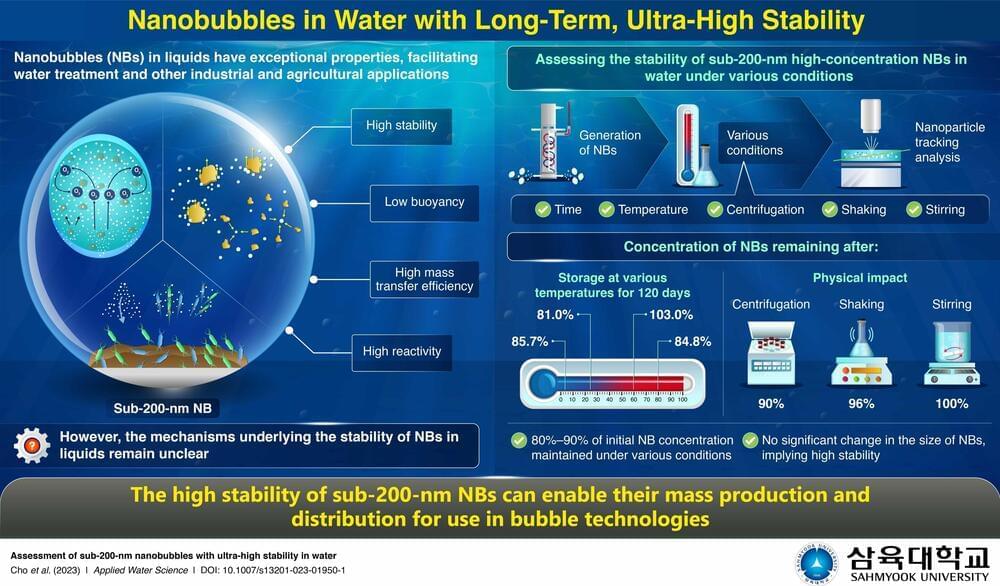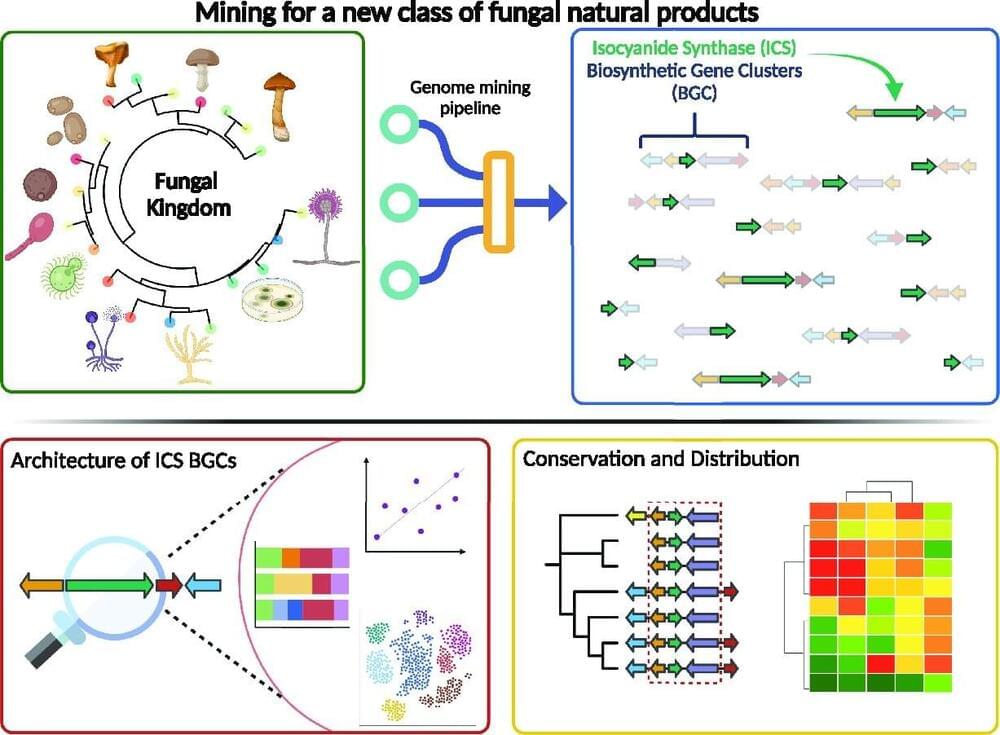Difficulty swallowing (dysphagia) affects your quality of life and your health. The ability to safely swallow is vital for adequate nutrition and hydration, and it prevents foods and liquids from entering your lungs, where they can cause pneumonia.
Archive for the ‘food’ category: Page 57
Jul 27, 2023
The AAAAI explains Food Protein-Induced Enterocolitis Syndrome (FPIES) written and reviewed by experts on allergies
Posted by Shubham Ghosh Roy in categories: food, health
Jul 27, 2023
Biotechnology giant: Does China now lead the world in human and agricultural genetic engineering?
Posted by Dan Breeden in categories: bioengineering, biotech/medical, food, genetics
For many people, when they hear China and genetic engineering in the same sentence, it is often synonymous with scandal.
Jul 26, 2023
Researchers take a closer look at ultra-high stability nanobubbles
Posted by Genevieve Klien in category: food
Bubble technology has emerged as a powerful tool for addressing environmental pollution, enhancing water treatment processes, and boosting industrial and agricultural production. Such novel applications of this technology have emerged owing to the unique properties of nanobubbles (NBs)—gas bubbles smaller than 1,000 nanometers (nm) in diameter.
In particular, NBs in water, especially those with diameter less than 200 nm, exhibit low buoyancy, high mass transfer efficiency, high reactivity, and exceptional stability. However, the underlying mechanism behind their stability has remained elusive, with most studies focusing only on the temporal changes in the size and surface charge of NBs and overlooking the changes in their concentration under various conditions.
To address this issue, a team of researchers led by Associate Professor Myoung-Hwan Park from Sahmyook University in South Korea has recently investigated the number and stability of high-concentration NBs in water under various conditions. Their study was published in Applied Water Science.
Jul 23, 2023
Milk Proteins—Their Biological Activities and Use in Cosmetics and Dermatology
Posted by Omuterema Akhahenda in categories: biotech/medical, chemistry, food
Milk and colostrum have high biological potential, and due to their natural origin and non-toxicity, they have many uses in cosmetics and dermatology. Research is ongoing on their potential application in other fields of medicine, but there are still few results; most of the published ones are included in this review. These natural products are especially rich in proteins, such as casein, β-lactoglobulin, α-lactalbumin, lactoferrin, immunoglobulins, lactoperoxidase, lysozyme, and growth factors, and possess various antibacterial, antifungal, antiviral, anticancer, antioxidant, immunomodulatory properties, etc. This review describes the physico-chemical properties of milk and colostrum proteins and the natural functions they perform in the body and compares their composition between animal species (cows, goats, and sheep). The milk-and colostrum-based products can be used in dietary supplementation and for performing immunomodulatory functions; they can enhance the effects of certain drugs and can have a lethal effect on pathogenic microorganisms. Milk products are widely used in the treatment of dermatological diseases for promoting the healing of chronic wounds, hastening tissue regeneration, and the treatment of acne vulgaris or plaque psoriasis. They are also increasingly regarded as active ingredients that can improve the condition of the skin by reducing the number of acne lesions and blackheads, regulating sebum secretion, ameliorating inflammatory changes as well as bestowing a range of moisturizing, protective, toning, smoothing, anti-irritation, whitening, soothing, and antiaging effects.
Keywords: milk, colostrum, casein, β-lactoglobulin, α-lactalbumin, lactoferrin, growth factors, skin, regeneration, antimicrobial, cosmetics.
Although milk is known to be used as a raw material in the food industry, it is also widely used in the pharmaceutical and cosmetic industries due to its considerable biological potential. It has also been the subject of detailed analyses and discussions of its individual components and their properties [1, 2].
Jul 22, 2023
Timelapse of Future BIOTECHNOLOGY
Posted by Jose Ruben Rodriguez Fuentes in categories: bioengineering, bioprinting, biotech/medical, chemistry, cyborgs, food, robotics/AI, transhumanism

What happens when humans begin combining biology with technology, harnessing the power to recode life itself.
What does the future of biotechnology look like? How will humans program biology to create organ farm technology and bio-robots. And what happens when companies begin investing in advanced bio-printing, artificial wombs, and cybernetic prosthetic limbs.
Jul 22, 2023
It’s Raining Antibiotic Resistant Bacteria
Posted by Joseph Barney in categories: biotech/medical, education, food

This is an educational video. It does suggest a bit of a solution and it’s a good reason to be careful about eating snow maybe or drinking rain water? I’m no expert but now I’m wary though I haven’t heard of anyone getting sick from doing so.
Bacteria are everywhere, including clouds, and the rain that falls from them. Not only can they survive the harsh environment and hitchhike across continents, they can share their genes, too. Including the ones that make them resistant to antibiotics.
Continue reading “It’s Raining Antibiotic Resistant Bacteria” »
Jul 21, 2023
Food allergies impair growth among infants
Posted by Shubham Ghosh Roy in categories: biotech/medical, food, health
Children with food protein-induced allergic proctocolitis experienced impaired growth during their first year of life, but this resolves as the disease resolves, according to a study published in Annals of Allergy, Asthma & Immunology.
Meanwhile, children with IgE-mediated food allergy (IgE-FA) experienced impaired growth after age 1 year, Rachael Rosow, BA, clinical research coordinator for pediatric food allergy at Massachusetts General Hospital at the time of the study and now a medical student at Frank H. Netter M.D. School of Medicine at Quinnipiac University, and colleagues wrote.
The 804 children followed from birth through age 2 years in the study included 134 (17%) who developed food protein-induced allergic proctocolitis (FPIAP), 50 (6%) who developed an IgE-FA and 15 (2%) who developed both.
Jul 21, 2023
Fueled by new chemistry, algorithm mines fungi for useful molecules
Posted by Genevieve Klien in categories: biotech/medical, chemistry, computing, food, genetics, information science
A newly described type of chemistry in fungi is both surprisingly common and likely to involve highly reactive enzymes, two traits that make the genes involved useful signposts pointing to a potential treasure trove of biological compounds with medical and chemical applications.
It was also nearly invisible to scientists until now.
In the last 15 years, the hunt for molecules from living organisms—many with promise as drugs, antimicrobial agents, chemical catalysts and even food additives—has relied on computer algorithms trained to search the DNA of bacteria, fungi and plants for genes that produce enzymes known to drive biological processes that result in interesting compounds.
Jul 21, 2023
Amazon to launch pay-by-palm technology at all Whole Foods stores by year-end
Posted by Kelvin Dafiaghor in category: food
Amazon One lets users enter and pay for items in stores by swiping their hand over a kiosk.















